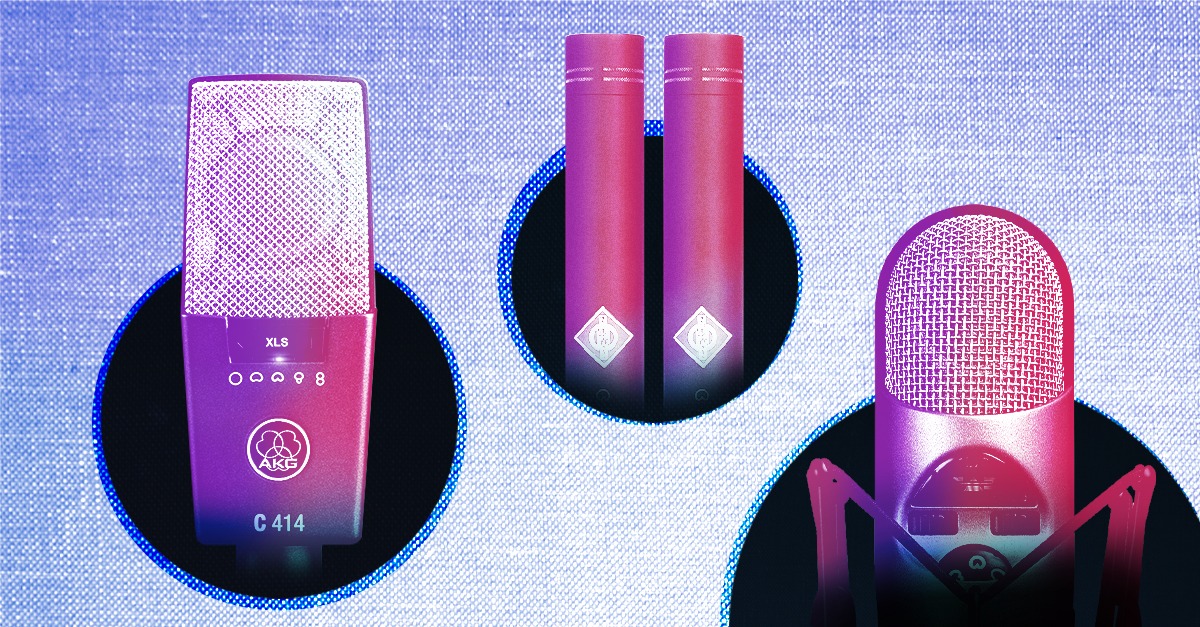
Condenser Microphones: Record Studio Vocals and More

No home studio is complete without at least one microphone—especially if you want to record vocals.
To do it right you’ll need a mic and audio interface to get them into your DAW.
But there are a few different types of microphones out there. Not every microphone works well for every source.
In this article I’ll be talking about condenser mics. This is the mic type most often associated with studio vocals, but there’s a lot more to them than that!
What are condenser mics?
Condenser mics are microphones that use an electronic capacitor to convert acoustic vibrations into a signal.
This method of generating a signal makes condenser mics extremely sensitive. That means they can capture a ton of detail and work well on quiet sources.
Condenser mics contain active electronics, which means they need a power supply to operate.
Condenser mics contain active electronics, which means they need a power supply to operate.
In most cases 48v phantom power from your audio interface will do the trick.
But some vintage-style microphones require an external power supply—especially if their circuitry uses vacuum tubes.
Large diaphragm condenser microphones
Large diaphragm condenser microphones are probably the first thing that comes to mind when you think of studio recording mics.
These are the large, stylish and serious looking mics that you see in most professional recording situations.
Large diaphragm condensers (or LDCs for short) have several important qualities and benefits for recording.
They have extremely low self-noise, which makes them effective for recording very quiet or dynamic sources.
But more than anything else, LDCs have a characteristically pleasing sound especially for vocals.
The reason why is fairly technical, but it’s mostly a combination of proximity effect and the polar pattern deforming slightly at lower frequencies.
The result is the big, bold and powerful sound of studio vocals that we’re accustomed to today.
Small diaphragm condenser microphones
Small diaphragm condensers are the smaller, less flashy cousins of the LDC.
Sometimes called pencil condensers, SDCs have their own set of benefits.
Sometimes called pencil condensers, SDCs have their own set of benefits.
The polar pattern of small diaphragm condensers is extremely consistent throughout the frequency range. They also have excellent transient response.
That makes them perfect for recording percussion, acoustic instruments, or anything else that requires detail and realism.
They’re also great to use in a stereo setup to capture a real environment—many SDCs come in matched pairs just for this purpose.
What to record with condenser mics
As with any type of microphone there are a handful of sources that are well suited to capture with condenser mics. I’ll go through the list of the best things to record with condensers:
1. Vocals
Vocals are a perfect source to record with condenser mics.
With some notable exceptions (like screaming or other aggressive styles), the majority of studio vocals are recorded with large diaphragm condenser mics.
The detail, realism and larger-than life quality of LDCs provide much of the sonic character that we associate with recorded singing.
The detail, realism and larger-than life quality of LDCs provide much of the sonic character that we associate with recorded singing.
2. Realistic stereo
A pair of small diaphragm condensers can be arranged in a pattern to produce an extremely realistic stereo image.
In fact, the microphone type you’ll most often see on a portable field recorder is a small diaphragm condenser.
Anytime you need to record a a convincing stereo sound that seems like you’re “right there in the room” SDCs are a great option.
3. Acoustic instruments
The realism and detail of condenser mics makes them ideal candidates for recording acoustic instruments.
Acoustic guitar, horns, stringed instruments like violin or upright bass are great candidates for either LDCs or SDCs.
4. Bass drum
Many engineers record kick drum by placing one mic inside the drum through the port hole and another on the outside of the drum in front of the skin.
Most often, they choose a dynamic mic for the inside of the drum to capture the transient punch of the beater.
A large diaphragm condenser can be a great choice for the outside of the kick drum. The extra proximity effect of cardioid LDCs can reinforce the low end of the drum nicely.
5. Overheads
Before the ribbon revolution, it was common to see small and large diaphragm condenser mics used as drum overheads.
In some situations, they can still be a great choice. For a brighter sound with more air and cymbal sizzle, use a pair of SDCs.
Large diaphragms can also have interesting characteristics when used as overheads.
Condensers are a great option for overheads in acoustic music or wherever realism and detail are required.
The right tool for the job
Every producer should have at least one condenser mic in their collection if they plan to record vocals.
But there’s a lot more to this great microphone type than just capturing singers.
Whether you want to record an intimate acoustic guitar performance or catch the booming low end of a bass drum, there’s knowing where and when to use condensers will help you get the sound you need.
Gear guides, tips, tutorials, inspiration and more—delivered weekly.
Keep up with the LANDR Blog.




